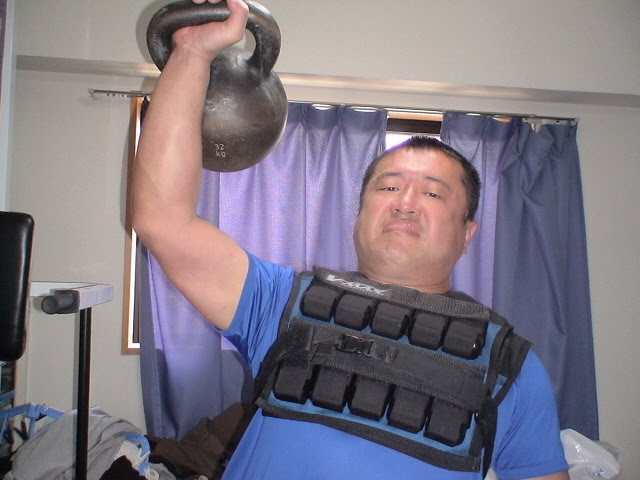Archive for the ‘BodyBuilding’ Category
Myostatin drug breakthroughs
It seems those myostatin blocking drugs are not far off. They will be beneficial in fighting cancer, aging and enhancing performance.
From http://www.acceleronpharma.com/content/products/ace-031.jsp
ACE-031 (Neuromuscular Disease)
ACE-031 is a novel, muscle-building agent that is being developed for the treatment of patients with neuromuscular diseases with the goal of improving strength and preserving physical function.
What is ACE-031?
ACE-031 is an investigational protein therapeutic that builds muscle and increases strength by inhibiting molecules that bind to and signal through a cell surface receptor called Activin Receptor Type IIB (ActRIIB). ACE-031 is a recombinant fusion protein that is produced by joining a portion of the human ActRIIB receptor to a portion of a human antibody. This creates a freely circulating, decoy version of ActRIIB which removes proteins, such as GDF-8 (myostatin) and other related molecules that limit the growth and strength of muscle.
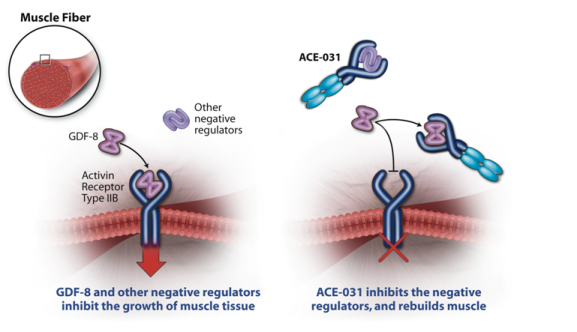
The Role of ActRIIB Signaling and Muscle Growth
Muscle growth is regulated by proteins in the TGF-? protein superfamily that serve as “on” or “off” switches for muscle production. Several molecules including GDF-8 interact with the ActRIIB receptor and send an “off” signal to stop muscle production. In the absence of these “off” switch molecules that signal through the ActRIIB receptor, muscle mass increases dramatically.
In nature, this effect has been observed in numerous species, particularly in animals that have been bred for increased musculature and strength. For example, Belgian Blue cattle lack the gene for GDF-8, which is one of several molecules that activate the ActRIIB receptor. A deficiency of this protein results in cattle with tremendously developed musculature and strength. Similar effects have been observed in other species, including rodents, dogs and even humans.
Treatment with ACE-031 Builds Skeletal Muscle
Treatment with ACE-031 promotes muscle growth by inhibiting ActRIIB signaling. ACE-031 binds to proteins that signal through the ActRIIB receptor to limit muscle growth. When ACE-031 binds to these proteins, it prevents them from interacting with the ActRIIB receptor, thus allowing muscle to grow. Moreover, because ACE-031 prevents GDF-8 and other proteins that regulate muscle mass from signaling through the ActRIIB receptor, its effects on lean muscle exceed those of inhibitors of GDF-8 (myostatin) alone.
Non-Clinical Results – When animals are treated with ACE-031, they experience growth in lean muscle and are considerably stronger than their untreated counterparts. This has been shown in several species, and in both healthy animals and in animals with diseases associated with muscle weakness and wasting.
Clinical Results – Recently, Acceleron completed a clinical study of ACE-031 in healthy volunteers. These subjects received a single dose of ACE-031 across a range of dose levels. At higher doses, the effects of ACE-031 on skeletal muscle were encouraging. After a single dose of ACE-031, subjects developed roughly 1 kilogram (over 2 pounds) of muscle at 2 weeks. Moreover, ACE-031 was well-tolerated at all dose levels, with only mild or transient side effects observed.
Effects of Single-Dose Treatment of ACE-031 on Lean Mass (Human)
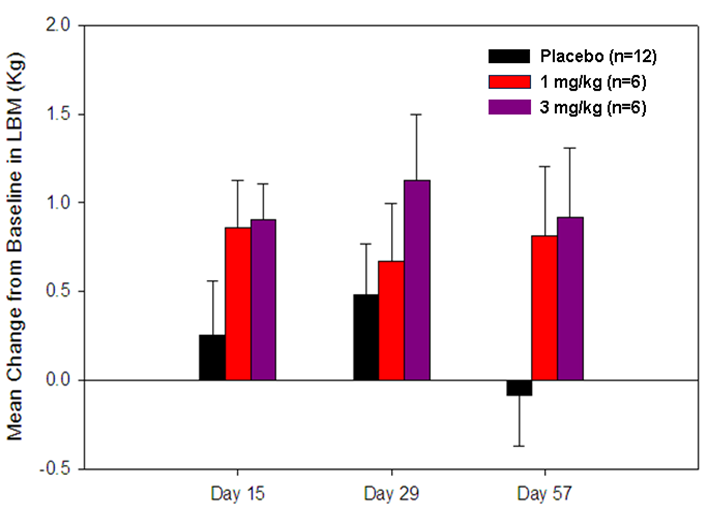
Acceleron is developing ACE-031 for the treatment of patients with neuromuscular diseases, such as Duchenne Muscular Dystrophy (DMD) and Amyotrophic Lateral Sclerosis (ALS), with the goal of improving strength and preserving physical function. By affecting the muscle directly, ACE-031 may one day offer hope to patients suffering from these debilitating diseases.
References
A mutation in the myostatin gene increases muscle mass and enhances racing performance in heterozygote dogs, Mosher DS et al. PLoS Genet 3(5): e79, 2007.
Regulation of muscle growth by multiple ligands signaling through activin type II receptors, Lee SJ et. al., PNAS 102:18117-18122, 2005.
Inhibition of myostatin in adult mice increases skeletal muscle mass and strength, Whittemore LA et al., Biochem Biophys Res Commun. 2003 Jan 24;300(4):965-71.
Regulation of myostatin activity and muscle growth, Lee SJ et. al., PNAS, 98:9306-9311, 2001.
From http://www.nature.com/news/2010/100819/full/news.2010.419.html
Drug flexes muscle against cancer
Decoy protein helps to fight cancer in mice by stopping muscle breakdown.
Researchers have created a molecule that, in mice, can fully reverse the devastating muscle loss that often accompanies advanced cancer — and thereby increase the lifespan of animals with the disease.
The molecule blocks the activity of a key muscle-limiting protein called myostatin by acting as a decoy. Instead of myostatin binding to its normal receptor and triggering muscle wastage, it is ‘mopped up’ by binding to the decoy molecule instead.
Muscle wasting — called cachexia — is thought to account for about 30% of deaths in patients with cancer, but how exactly cachexia is spurred by cancer — or indeed exactly how it leads to a patient’s decline — isn’t known. It is thought that several molecular pathways work in tandem, “activating an axis of evil to control muscle mass in a negative way”, says H. Q. Han, lead author of the study and scientific director of the metabolic disorders division at Amgen, a biotechnology company in Thousand Oaks, California.
Han and his group wanted to find the dominant pathway responsible for cancer cachexia, and then design a way to block it in order to treat patients. Several studies have shown that blocking the myostatin pathway can promote muscle growth, says Han, and some have shown that a molecule closely related to myostatin, called activin A, becomes more abundant in patients with some cancers.
“We examined a large random collection of cancer cell lines in vitro, and found that one-third of them secreted large amounts of activin A,” says Han. “This led us to believe that activin A must have some systemic function when overproduced in a cancer setting.”
Muscling in
The researchers created a soluble version of the activin A receptor — which is thought to affect both myostatin and activin A signalling — by fusing a piece of human activin receptor to an antibody. This decoy mopped up the ligands that usually bind to the real receptor, thus blocking receptor activation.
“There’s really an overwhelming amount of data now showing the benefits of targeting this pathway.”
A single injection of the soluble receptor into normal mice boosted their muscle mass by 25% or more in a week or two. When it was given to mice implanted with colon cancer cells, their muscle mass returned to normal, even though their tumours continued to grow. Strikingly, all of the animals that did not receive the soluble receptor were dead 40 days after cancer cells were implanted, but more than half of the treated animals survived to this point. The study will be published tomorrow in the journal Cell1.
Han’s group isn’t the first to try to manipulate the myostatin pathway to treat muscle wasting. “There’s really an overwhelming amount of data now showing the benefits of targeting this pathway,” says Se-Jin Lee, a molecular biologist at Johns Hopkins University in Baltimore, Maryland, who co-discovered the myostatin gene and its role in regulating skeletal muscle mass in 19972.
The fact that disrupting the myostatin pathway caused such strong muscle regrowth isn’t so surprising, says Lee, because other studies have shown that this pathway has an extremely negative effect on muscle growth.
Ken Fearon, a surgical oncologist at the University of Edinburgh, UK, who has studied cancer cachexia, agrees. “They’ve antagonized one of the main in vivo brakes” to muscle growth, he says. “If you take the brakes off a car, it’ll keep going down the road.”
Limited options
What is most exciting is that the treatment prolonged survival, according to Lee and Fearon, because few treatments for cancer cachexia currently exist. “The reason that oncologists don’t bother measuring — let alone treating — cachexia is that they feel their options are so limited outside of treating the cancer,” Fearon says.
Despite the molecule’s powerful effect in mice, “does blocking this pathway in humans also cause muscle to grow?” asks Lee. “That question has not been answered yet.”
It is also still unclear whether the myostatin pathway plays a causative role in regulating the condition, he says, and the study doesn’t provide all the answers. “The fact that you can prevent the muscle loss doesn’t say that it’s due to overactivity in this pathway,” he notes.
Several pharmaceutical and biotech companies have begun clinical trials to test compounds that target the myostatin pathway. In the only such study published so far, researchers from Johns Hopkins University and drug firm Wyeth (now part of Pfizer) used an antibody to block myostatin in an attempt to treat the muscle-wasting disease muscular dystrophy3. “Those results were quite wishy-washy,” Lee says.
Other trials, including on testing a similar form of the soluble activin A receptor by pharmaceutical company Acceleron, based in Cambridge, Massachusetts, are still in progress. Unlike many of the other compounds being tested, says Lee, this particular compound can bind not just to myostatin and activin but also to many other related molecules. This could make it more potent, he notes, “but of course it might also be the downfall” if this lack of specificity leads to unwanted side effects in patients.
*
References
1. Zhou, X. et al. Cell 142, 531-543 (2010).
2. McPherron, A. C. et al. Nature 387, 83-90 (1997). | Article
3. Wagner, K. R. et al. Ann. Neurol. 63, 561-571 (2008). | Article
Kettlebells + Weightvest = Killer !!!
Yes I convinced the gym instructor at my gym some months ago to buy some KB’s.
Coz they ain’t cheap – right ? I used them a bit but found it a little lame. Well having got my new weight vest it seemed the KB’s may be a good combination.
Some barbell work is inconvenient with a vest (like bench press) – dead lifts are excellent though.
Same with machines – its not quite what the vest was designed for.
Kettlebells’s and the weight vest give the most killer intense workout you can imagine. Throw in some dead lifts and barbell curls and you will be sore the next day.
I like to use my vest for 3 hours at a stretch. Normally this will include a weights workout and a good long walk.
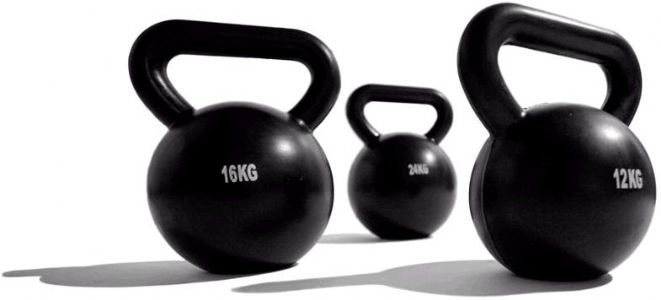
THIS IS NOT ME (I’m handsome) LOL
Image from : http://swingsnatch.blogspot.com/
Really training with Kettlebells alone is lame – once you have hit them with a vest there is no turning back.
Weight vests are serious kit – DO NOT RUSH !!!
Be very careful to break in to using a vest – no plyometrics for the first 3 months. No running or jumping for the first 3 months.
You want your hips, spine & knees to slowly adapt to the added weight. Do stretches and joint strengthening to adapt to the vest. After some weeks you can slowly add more movement oriented exercise.
Weight training and walking are fine for the beginning as are low impact calisthenics like push ups and pull ups.
After time you can add weight and plyometric moves.
My Weight Lifting Gear
I was sixteen when I started lifting. I got two dumbells and a barbell for my 16th birthday. I used to train at a small town gym too.
At nineteen I finally left home and started training at Youthtown gym in Auckland. At that time & for many years it was a power lifters gym & many competitive Olympic lifters trained there.
I’ve trained at this same gym for 23 years now.
At Home I have a bunch of stuff:
2x Fat grip dumbells
Weight vest
Gripstik
Power Twister
Chest Expander
Eagle Catcher
Hand Grippers
EMS machine
Sledge Hammer
Jump Rope
So although I hit the gym 3-4 times a week if I am not sick or busy with work I can still squeeze in a decent workout at home.
Its Weight Vest Time
Today I finally bought my first weight vest. I wore it for 3 hours straight away to test it out. Its only a 40 lb model so this was not challenging although I was glad to get it off by the end.
I intend to add steel shot to the vest over time and increase the weight.
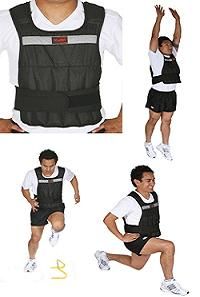
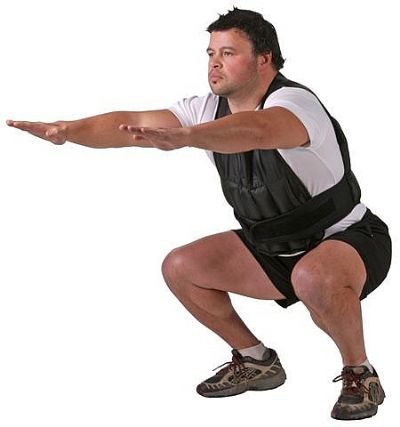
Grip Training will Blast Your Bench
Finally after many months I am seeing a huge pay off in my Bench Press from grip training. I normally do my Bench work on a machine as I don’t have a training partner.
I like to train alone so thats the way it must be. So the stack on my bench machine has 96 KG max. I stack 20 KG plates onto the machine to add weight.
So several months ago I thought I was doing good benching 300 lbs. Yesterday I did 4 reps with 387 lbs. My goal is 400 lbs by the end of the year which should be easy given its only July. My 387 was after 5 sets ranging up from 300 lbs. The odd thing is I don’t feel any stronger than I did months back and honestly apart from my hands and forearms I don’t think I am.
The other trick I know for bench is to squeeze the traps all through the range of motion both up and down. Also you want to do serious stretching with a stick and with swinging arms between each set.
Kung Fu and BodyBuilding
Many of us western strength athletes are shocked when we discover that most of our precious exercises were in use hundreds of years ago in China.
Weight vests, kettle bells, wrist rollers, progressive resistance, all of these and much more are actually part of Kung Fu conditioning. So Kung Fu is a great adjunct to weight training and bodybuilding as practiced in the west.
In addition to the muscle building we have honed in the west the Chinese developed knowledge of electro physiology in the form of the meridians and points that western science did not discover.
They also developed methods for developing the bones and tendons to withstand the rigors of warfare.
Personally I am now 5 months into a daily Iron Palm regime, training to smash objects with my bare hands. I am being very careful to avoid arthritis and damage. Daily I apply Chinese Dit Da Jow liniment. Soon I will begin internal medicine to aid recovery also. I am adding Iron Arm conditioning for my fore arms and in a month will also begin Iron Shirt Chi Kung to condition my entire body.
On top of this I do my regular weights and jump rope cardio. So it makes for a busy schedule.
Who is the worlds fittest man ?
Joe Decker certainly is publicized as the worlds fittest man. His website is at http://www.gutcheckfitness.com/About_Joe.html
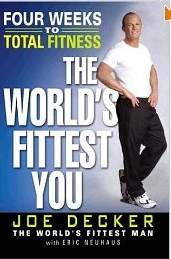
Joe is a super fit dude but is he really the worlds fittest ? I seriously doubt it. Paddy Doyle an ex paratrooper from the UK http://en.wikipedia.org/wiki/Paddy_Doyle is also making a similar claim.
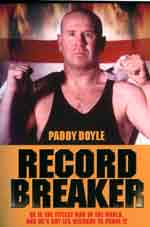
Well lets face it within certain careers such as elite military units, forestry lumberjacks etc there are many individuals that are super fit. Far beyond the norm even by athletic standards.
The Guiness book of records sets a standard and records it for all to see.
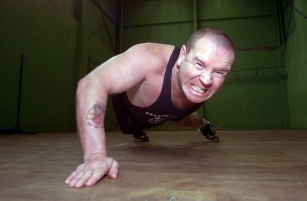
Paddy Doyles feats include:
* A two mile swim
* Weightlifting 300,000 pounds in a single session
* A 12-mile run
* A 12-mile walk Carrying 25 lb back pack.
* A 110-mile bike
* 1,250 press ups (push ups)
* 3,250 sit-up crunches
* 1,250 star-jumps (Jumping Jacks)
* 20 miles rowing
* 1,250 standing hip flexors {Lifting 10 lb weights}
* 20 mile cross trainer
Other records include:
* 1,500,230 push-ups in one year {World Record}
* 1,940 back of hands pushups in one hour {World Record}
* 29,850 fullcontact straight arm punch strikes in 1 hour {World Record}
* 932 sit ups with a 50 lb weight on chest in 30 mins {World Record}
* 1 mile run carrying a 40 lb back pack 5 mins 35 secs {World Record}
Its very impressive and Decker can boast of similar prowess. Both guys have books that can give you something to start with in your own quest for super fitness.
Myostatin Genetic Muscle Killer
Myostatin suppression holds much hope for us muscle heads and we can be assured that in the near future a means will be found to exploit this gene and suppress its expression.
If you do a little research on Google you will come across Wendy the Wippet – a Myostatin deficient dog & no doubt some photo’s of Belgian Blue cattle.


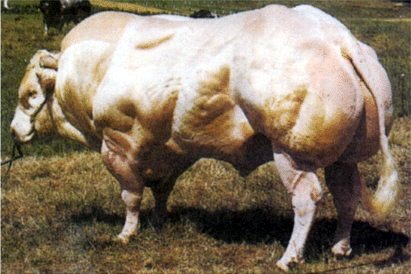
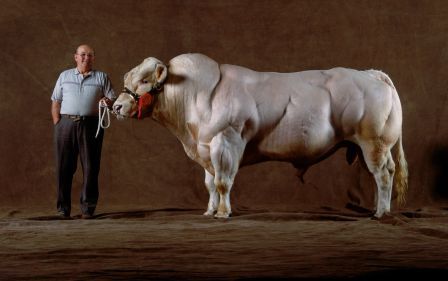
These animals are so muscular because their bodies lack expression of the Myostatin gene which prevents muscle growth. Some humans also lack this gene and are exceptionally strong, lean and muscular.
The fact is that a human fully developed like these animals might carry 4-8 stone more muscle than a normal human athlete. Really most of us would be better off with just 3-4 more stone.
Anything more than this can cause tendon problems & “maybe” overburden the internal organs but this is to be proven.
Several supplements have been released claiming to suppress Myostatin such as brown seaweed & MYO-T12 which contains processed fertile egg yolks (hens lay eggs even without sex). Both of these contain follistatin which suppresses myostatin. However the body can not absorb the follistatin. Both products are hogwash and I strongly recommend you do not waste your money.
The good news is that research has proven heavy weight training does temporarily lower myostatin levels. Even better protein taken both before & after workouts further lowers myostatin and allows the body to grow.
More research will tell us the exact protein mix that is most effective. For now forget the bogus egg yolk supplements and take quality proteins before and after training.
Training For The Iron Palm
I had a serious attack at Iron Palm many years ago when I was in the army and doing a bit of kick boxing and stuff.
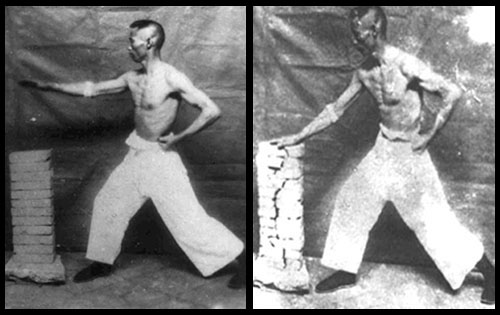
The years passed and I let the training slip only doing it sporadically. Back then I did manage to break a marble slab, these days I am just getting back into it so am not trying to break anything.
I feel its an excellent adjunct to grip and forearm training as most iron palm proponents do not possess great grip strength and most people with great forearm power are not iron palm.
There are lots of great sources of information online for iron palm these days. I prefer to train on concrete but just bought a bag and filled it with a 4 meter chain.
Concrete feels better – its solid and it vibrates. However the bag is better for the back of the hands.
I have also found a multitude of dit da jow formulas and suppliers. 10 years back all this was harder to come by.
So my present crush on the gripper is 250 lbs. In 3 months that may be 270 lbs. By then with daily practice I should have iron palm also. Then Its just a matter of continuation.
The dude at www.ironpalm.com can crack a coconut with the back of his hand. This for me I feel would take 2-3 years to accomplish if I combine it with a grip & forearm program also (and an inhuman dedication). Coconut breaking is quite an accomplishment.
His series of videos is available for about $20 us each. There are many Iron Palm courses now.
William Cheung & Brian Gray also offer programs as does Thomas Keen.
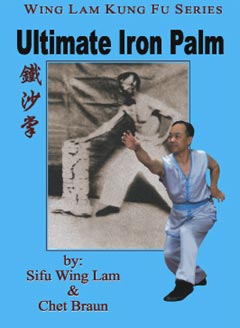
Popular Iron Palm Book
Heres a simple program:
Get some dit da jow off the net or from a Chinese Herbal Shop.
Find a waist high concrete wall or flat steel surface and simply slap the surface for several minutes with the liniment on your hands. Don’t slap hard just as hard as possible with no pain or discomfort.
Do the heel of the palm, knife edge and back hand also.
Do this for several minutes on each strike 3X per day using the liniment also.
Its actually quite relaxing to stand there slapping away although my neighbors think I am crazy.
I don’t train my knuckles & in the army they told us not to strike with them. You can however do fingertip pushup’s and everything involved in grip training. Backhand strikes will condition the knuckle also.
Another thing thats popular is hot and cold water dips for the hands. I have not tried stabbing my hands into a bucket of rice but Lee Hayward recommends this as part of his grip training so I may try that soon.
After a few months you will be able to break stuff. Its quite simple.
Good Old Dit Da Jow
You gotta get this stuff if you are serious about grip & hand training – Its the secret liniment used in iron palm and iron fist.

Its not secret at all really and I got mine at the Chinese herb shop 3 minutes walk from home.
Its great for preventing or treating tendinitis and rheumatism.
I also picked up an Eagle Catcher for finger training – no where near as good as the super gripper but an excellent device anyway.


Its a shame they don’t come with varying spring strengths. I have a feeling the attachments on this would snap with stronger springs. This means it will be used for isometric timed holds.
